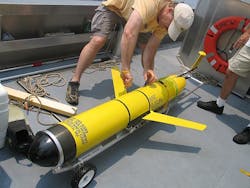Navy looks to Teledyne Benthos for long-duration UUV sea glider persistent surveillance of ocean depths
ARLINGTON, Va., 5 Jan. 2014. U.S. Navy researchers are working with unmanned underwater vehicle (UUV) experts at Teledyne Benthos Inc. in Fall River, Mass., to develop long-range and long-duration UUV technology that can harvest energy from the difference of ocean temperatures at different depths.
Officials of the Office of Naval Research (ONR) in Arlington, Va., are awarding a $203,731 contract to Teledyne Benthos for a project called Long Endurance, Transoceanic Gliders Harvesting All Energy From The Ocean Thermocline.
Related: Teledyne Technologies becoming major player in unmanned underwater vehicle (UUV) sensors
For this project, Teledyne Benthos experts will investigate technologies that could enable UUVs to conduct long-duration persistent surveillance of the ocean in different regions and different depths.
The ability to sample ocean water at different depths could help Navy experts calibrate sonar for efficient anti-submarine warfare (ASW), as well as detect quiet nuclear or diesel-electric submarines or hidden minefields. Data gathered by long-duration UUVs also could help Navy scientists with weapons and sensor research.
For this project, Teledyne Benthos will use sea glider technology. Sea gliders are long-endurance UUVs that control forward motion with differences in buoyancy.
Related: Navy researchers choose underwater glider UUV sensors from AML Oceanographic
Sea gliders can rise to the surface, stick an antenna out of the water to communicate with controllers or with GPS satellites. Then the UUVs make themselves more heavy to sink themselves. As the craft descend, control surfaces propel it forward, similar to the way glider aircraft maneuver without power. Sea gliders are among the most power-efficient unmanned subsea vehicles.
Teledyne Benthos has designed the Slocum Glider, which can be powered by batteries or by a thermal engine. The thermal glider version of the Slocum Glider offers long range and endurance using environmental energy via a thermal engine.
A thermal engine, or "heat engine," converts thermal energy into mechanical energy to power the sea glider's control surfaces, buoyancy system, and communications. The thermal engine exploits changes in temperature in the ocean's depths to generate power.
Related: NOAA asks industry for long-endurance UUV to profile ocean temperatures and salinity
The Teledyne Benthos thermal glider can be deployed in the ocean for as long as five years, operating anywhere from the surface to depths of nearly 4,000 feet. It has a range of nearly 25,000 miles.
Teledyne Benthos also designs an electric version of the Slocum Glider that runs on alkaline batteries. It can deploy for 15 to 30 days and has a range of nearly 1,000 miles.
For more information contact Teledyne Benthos online at www.benthos.com, or the Office of Naval Research at www.onr.navy.mil.

